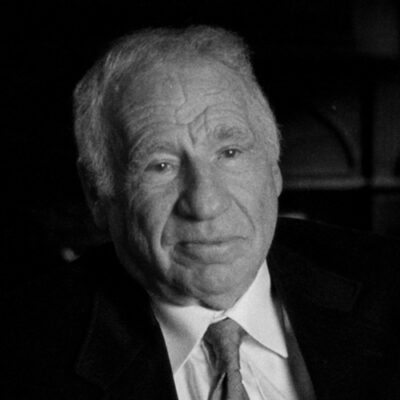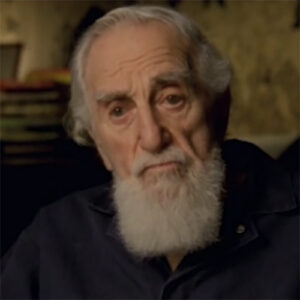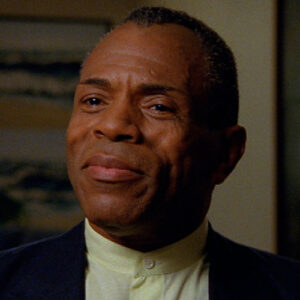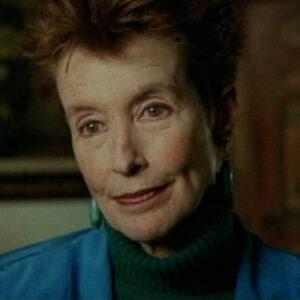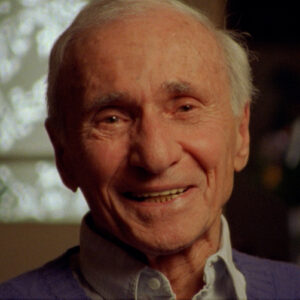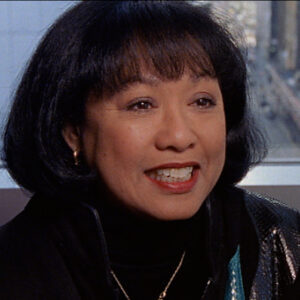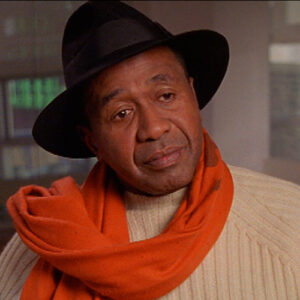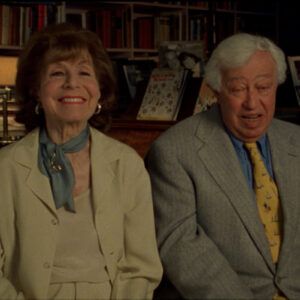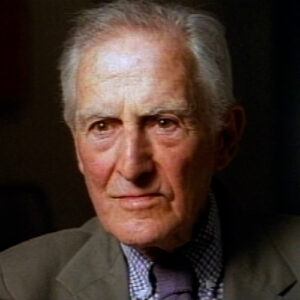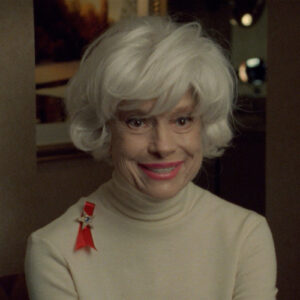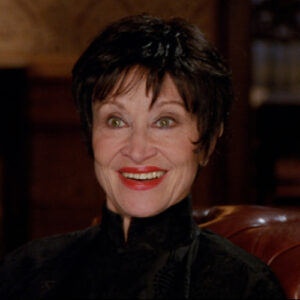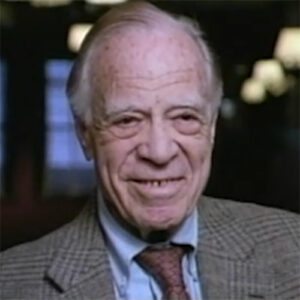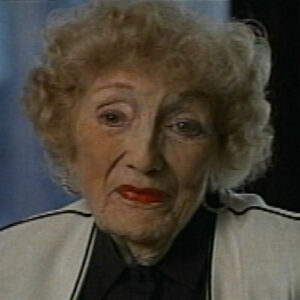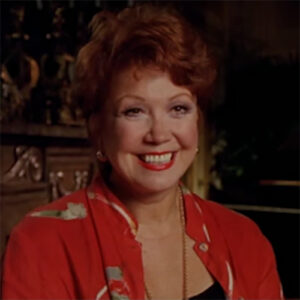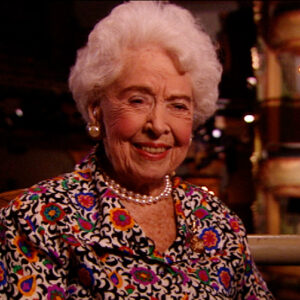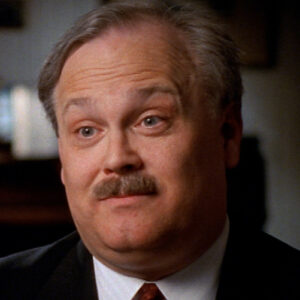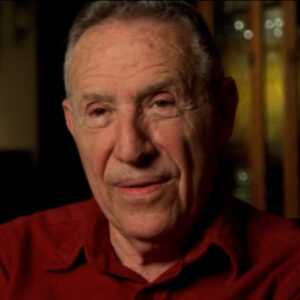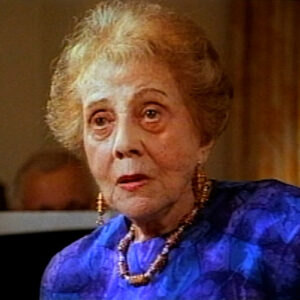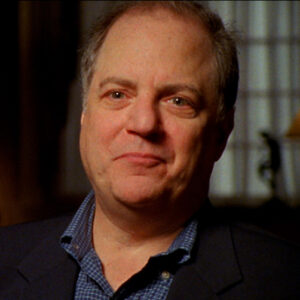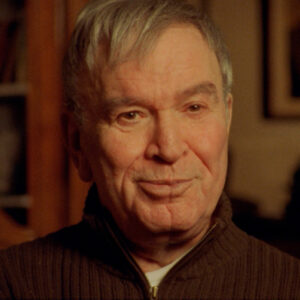Michael Kantor: Who was Ethel Waters?
Margo Jefferson: Who was Ethel Waters. It’s interesting that we do tend to say who was because we really ought to be saying who is Ethel Watters as we would say who is Billie Holiday, who is Fred Astaire. Ethel waters was and is one of the great popular singers. One of those who first joined City Blues, which was largely a female. Dominated form, the sweet version, as it’s called, with the conventions of, let’s say, Tintanale popular song over to, because she was a great kind of magpie and mimic, really up to and including certain conventions that we think of as art song. She liked her trills. All of those were in popular music, but, you know, she really was edging, edging towards it. She was a northerner, so you can also say she belongs to the first generation and was one of the first northerners, really, to help start a blues tradition. And that is one reason I think she’s been dismissed as inauthentic for so many years. She doesn’t really sing with the supposedly requisite southern accent, as if there aren’t many kinds of southern accents anyway. But she doesn’t sing with a requisite, this is the deep south accent that we’ve come to associate with blues. And she is in many ways, though she could do serious songs wonderfully, she’s also very much a comic artist and a satirist. She’s very witty. She improvises. She can be quite scathing. In her version of What Did I Do to Be So Black and Blue, she takes the Andy Rossoff lyric. This was first song. There’s an interesting history to this song. A gangster, I think it was Dutch Schultz, ordered Andy Rossoff to write these lyrics. He thought it would be hilarious to have a brown-skinned woman singing about how she couldn’t get a boyfriend. What did I do to be so black and blue? Andy Rosoff was not happy. And he got around it by writing a song that was in fact. It wasn’t just the barrel of laughs, even if that sorrow seems a little abject to us today. The first night that it was sung, there was absolute silence in the audience, and then this kind of burst of applause. So he had actually won out, especially at a time when, you know, Negroes and broad comedy were synonymous. All right, we now think of that song particularly in terms of. Armstrong’s great version where he dispenses with the verse and of course Ralph Ellison using it. In Invisible Man, Ethel Waters takes the verse which goes, Browns and yellows all have fellas, gentlemen prefer them light. And Ethel waters sings, all the race fellas crave high yellows, gentlemen prefer than light. Well, the racemen were, you know, the noble activists and intellectuals of the Harlem Renaissance. And yeah, plenty of them had light skin wives. So, you now, Ethel is really signifying and it’s terrific satire. That’s her improv. She’s constantly doing that. You know, she’s got her version of speech song. And she will, um… Take a convention that you find all through the 20s and into the 30s too. It began, I suppose, with the excitement of, my God, hot jazz. So then we have the kind of bifurcated black-white culture. We do, whether we’re black or white, but I think it must first have been terribly exciting when white singers did it. We sing one chorus sweet, today, my, and then. Today, my love, and the audience is beside itself with excitement. It became very quickly simply a convention. I’m sweet, I’m hot, la la la, get down. Ethel, if you listen to her doing this with a song like Am I Blue, it really does become organic. Organic in the sense of there’s a kind of character development, first of all. There’s a mood shift. You know, first verse, am I blue? I’m really thinking about it. Second verse, we are really all over. We’re scooping, we’re slurring, you know, we’re doing melisma. Well, the emotional pitch is higher. Not just despair, but a kind of defiance. And, you now, I’m mastering this one, which was really what she liked best. Mastering, not heartsickness. And you find that over and over with her. She just, when she imitates Armstrong, for example, in that great Dorothy Fields lyric, I can’t give you anything but love, she goes back and forth between a woman’s voice and a man’s voice. That is an imitation of Armstrong who’d recorded the song not long before. Well, it turns into a little drama. You know, immediately you’re hearing a woman fairly. Somewhat highfalutin, maybe, you know, a high yellow, maybe a white society dame, and some man who sounds a lot like Louis Armstrong who’s coming to visit her in her room and you’re going, whoa, these days, now that we are so interested in trans, trans, these day now that we’re so interested in transgressive gender play, an artist like Ethel Waters, like Mae West, becomes particularly interesting. You know, because we’re playing boys, we’re playing girls, we are playing femme, we are playing butch, you know we’re playing high culture, we playing low culture and mass culture because again this blend of styles is in fact the mass, what the mass culture popular singing style that people from Mildred Bailey, Lee Wiley to Billie Holiday albeit unacknowledged. To Bobby Short are all going to learn from.
Michael Kantor: Tell me about the world that Ethel Orders came from as a child.
Margo Jefferson: Ethel Waters. Yes, the world Ethel waters came from was as rough as it gets, which again, people need to remember when they talk about her as, you know, a little bit ditty as a singer. She was born in Philadelphia in, as it turns out, 1896, though she always said 1900. October 31st, Halloween. I think one reason she liked that Halloween 1900 was because she inaugurated the century and of course Halloween is perfect, you know, the creature, the woman of masks and contradictions. She was born and grew up in what people call the Bloody 8th Ward of Philadelphia. It was multiracial and unified by poverty as… As you could get, as they used to say, vice, criminality, desperation, crime, you know, thievery, I’m sure, you mean policemen, lots of prostitution. She was the result, in fact, of a rape. Her father, who was from a better family, quote unquote. Raped her mother as men from better families, so often felt they could, with women from less good families. Her mother had Ethel when I think she was about 12. The Waters’ father’s family couldn’t have cared less. Oh, no, we don’t believe it happened, and in any case, no. So, as she wrote in her really amazing, amazingly good… Um. Autobiography, His Eyes on the Sparrow, her mother never loved her and could never pretend to and she was gloomily wise enough to understand perfectly well why her mother ever could. She was raised by her grandmother who worked egregiously hard and by several aunts who Apparently sung well, were rather pretty and charming, and were drunkards. She was very good in school, very smart. She’s very funny about herself. She memorized everything, but she particularly loved curse words. And she loved, you know, scaring and thrilling and appalling everyone with all her violent expression. She says, my imagination flowered most lushly, you know when I was being violent. She and a lot of other little kids would, they formed little gangs and the prostitutes were very nice to them, so they would warn them whenever the police were coming around. And she says again that some of the, she learned some of her first lessons in loyalty and no doubt in some of the tougher ways that women get through life.
Michael Kantor: I have down here from 1915 to 24, she performed for only black audiences, so that’s the way it is.
Margo Jefferson: Yes, absolutely. She’s, first of all, she is going to, sneaking into little all-black clubs when she’s young. She’s working as a chambermaid. Let’s dispense with a few preposterously early marriages that got thrown aside. She’s a working as chambermaids and she has the show business bug. After she finishes doing the beds, cleaning the rooms in this hotel. She will stand in front of the mirror and do all the songs she’s seen in these clubs and speeches from all the plays, melodramas, comedies she’s seeing at the black theaters. She supplies applause, she supplies comments, she plays all the roles. You know, she’s also a good dancer. She is thin, we must remember this, those of us who think of her in the big days that go from onscreen appearances like a member of the wedding or pinky to Billy Graham. She’s skinny, she can shimmy, and yeah, she will be known as sweet mama string bean. Her first public performance takes place in a small Philadelphia. Um, 1917, she puts on a little fairly demure dress and sings W.C. Handy’s St. Louis Blues. She says she was the first woman to sing it and that she modeled her style after a female impersonator of the day who had had great success with it. She goes on the road, Black Vaudeville, shortly after that. And she’s a big hit, you know, but it’s pretty small time. Finally, she makes her way to New York, and again, she starts, as all black performers do, in little black clubs, Edmunds Cellar, places like that. She’s also, she’s touchy, she is proud, and she is, in a strange way, fearful. Whenever people try to push her, she says, oh, you know, no, I don’t think I can do And one of the things people suggest is, well, you know, why don’t you… You write some of your own blues, you sing some popular black songs, why don’t you sing, you know, some of the white songs of the day? No, I don’t think I could do that. I don’t think I can bring my style to it. Well, you now, a black kind of small time impessario producer persuades her to try it and she finds out that she can. Maybe, I think it’s Shine on Harvest Moon, an old Nora Bay song. And gradually, you know, she begins to incorporate these songs into her performances. She gets to the Cotton Club. You know, then she begins, of course, to sing songs by white composers of the day. And, in fact, singing Stormy Weather, that, you, you know beautiful Harold Arlen song is what leads her ultimately to. Our first white Broadway show.
Michael Kantor: She did do, you know, I guess, the black birds.
Margo Jefferson: Oh yes, which is actually a wonderful show. Lou Leslie’s Blackbird, it’s an all black cast though.
Michael Kantor: Tell me about…
Margo Jefferson: A review.
Michael Kantor: The review as thousands cheer and how Supper Time fit in or really didn’t fit in with the rest of the show.
Margo Jefferson: All right. Well, Irving Berlin had decided that he wanted to do fittingly, given the thirties and this new political consciousness that was making its way into popular culture. The review, which had been very light and entertaining in most cases through the twenties, was becoming sharp and politically aware. And Berlin, who was very much you know, a canny showman and a modernist about his music. He wanted to do a sharp, timely review. So he conceived of this as the songs would, each song would be attached to a newspaper headline. You know, some more serious than others. Ethel Waters had several numbers in this show, including. Heatwave, you know, which is certainly a high-spirited and in no way high-minded song. But Berlin did something really quite daring. He wrote a song for her called Supper Time, which many people might have first heard on a Barbara Streisand album and thought of as a torch song. But in fact, the headline in the show was Unknown, I think, or nameless, unknown Negro. Lynched by, I think it said masses, thousands of, you know, and this is still at a time when, you know, there’s a lot of lynching and very little legal action being taken. This is 1933. Then you see that headline, and, you know, imagine you’ve been seeing all these light performers you’re going to see, Clifton Webb and Marilyn Miller in a minute. The audience sees this headline. Then there is F.O. Waters standing, not dancing. But standing alone in what is clearly, you know, a kitchen. And she proceeds to sing, suppertime. I should set the table because it’s suppertime, sometime I, somehow I’m not able. Suppertime, I should sit the table because it is suppertime somehow I am not able because that man of mine ain’t coming home no more. And then it just quietly builds. So she knows. And it just must have been uncanny. He drew on her gift for understatement very condensed melodrama and this ability to build up something. And it was, you know, it floored people. In fact, Clifton Webb and Marilyn Miller did not want to have to go on after that. And there was some protest also about Waters taking her bows with the rest of the cast. And apparently Berlin, who again was canny at handling difficulties, simply said, well, you know, perhaps no one should take curtain calls. And that took care of it. And after that, she moved on to dramatic roles that were very much in keeping with the seriousness of the 30s and it’s… You know, digging into rural life and the common folk and the people she went on to, Mamba’s Daughters, by Dubose Hayward, Dubose believed Dorothy Hayward. And, you know that then led her to the plays we know, we know her best for, Member of the Wedding. It’s, you now, it’s a very interesting career in the later years, well, Cabin in the Sky in the 40s, which is wonderful, as she became bigger and bigger. She herself said, you know, this size of mine seals me off from the rest of the world. And increasingly, it sealed her off from any part, but some interesting variant, but nevertheless, another variant on, you now, a powerful, tragic, in some way, but surviving black matriarch, of de-sexed, essentially. Pivotal to the story, carrying history on her back. But the creature who had been sweet mama string bean, along with the person who could take tragedy and who could satirize race absurdities, that creature pretty much had to go, had to die, and be buried. Sophie Tucker, I think.
Michael Kantor: Claimed to be singing the blues or Broadway blues but in a way you placed her she she says they’re singing style is different from Bessie Smith and Ma Rainey absolutely she’s not a shouter no but that’s right but doesn’t she bring a certain style to Broadway that hadn’t been there what’s she the first well
Margo Jefferson: Well, you know, there are in black reviews, you know, they are other other things. I mean, even Bessie Smith has a short little show briefly on Broadway. Again, I would say she’s the first to bring let me think about this to fully to have fully fused. You know, the resources, the technical and emotional resources of blues singing and the torch song and, you know the worldliness, Tin Pan Alley worldliness and the kind of suave grief of the torch songs I would say or the suaveness of the.
Michael Kantor: Gershwin’s work, while unusual for Broadway, is part of the bigger trend, isn’t it?
Margo Jefferson: Yes, Gershwin’s Porgy and Bess is unusual for Broadway. But, you know, again, he was a man of his time. And artists in the 30s were going back to somebody’s roots, if not always their own. But they were turning in on America. This, of course, had a great deal to do with the depression and, you now, wrenching. Poverty with organizations like the WPA that would in fact send artists out into the countryside. So you would have James Agee and Edward Weston going out to photograph, you know, poor Southerners. You had whole teams of photographers. You had painters doing the same thing. You had writers like Steinbeck, Faulkner. Some of the stories of Catherine Ann Porter. Flankston Hughes had been doing that with his blues, but, you know, he kept on. You had Zora Neale Hurston publishing her Mules and Men, these novels that really, you now, unlike some of the Harlem Renaissance 20s novels, they are set in small southern towns. They take place in the south of the folk. Uh, much as he argued with her, you had… Young Richard Wright doing the same thing and those searing Uncle Tom’s children stories. This was happening all over. You had, in fact, even in terms of Broadway, the first impulse to write a ragtime, as it was put then, opera or a folk opera, that really is turn of the century. And among the, you know, famous Broadway, white Broadway composers. Irving Berlin used to say very early on that he wanted, he wanted to do this. Duke Ellington, you know, was turning to kind of my people, themes, Aaron Copeland was doing the same thing, and Martha Graham working sometimes with Copeland, sometimes otherwise, was doing this kind of thing in her dance, you had Emily Dickinson. That’s not rural, but it is. American roots. You had Eugene Loring. Oh God, I hope that was in the 30s. You’d better check that.
Michael Kantor: That’s plenty. Billy the Kid. Contextually. Okay. At least to photographers, you know, or what have you.
Margo Jefferson: Yes, you find this drive, this need, this impulse, you know, to go back to the roots of American culture, the land, the ordinary people, your folk or someone else’s folk, your folk in the extended way. In photography, the most famous would be Dorothea Lange and Walker Evans. We all still read the Evans, A.G. Tex, let us now praise famous men. In music, you have Erin Copeland, who is working sometimes with Martha Graham, the great choreographer. You have Ellington starting to turn to, you know, My People themes. You have novelists, short story writers. There’s Steinbeck. There’s Faulkner. There’s Katherine Ann Porter. It’s happening everywhere. There’s Zora Neale Hurston with her. Eyes were her anthropological book, their eyes were watching God, the novel, and Richard Wright doing his first short stories set in Mississippi. It’s an American movement.
Michael Kantor: Black idioms and black culture and what do you think?
Margo Jefferson: Then or now.
Michael Kantor: Then and now, do you think Porgy’s an authentic work of American art or is that putting you on the spot?
Margo Jefferson: You know, look, the so-called culture wars have been going on for years, just as there has always been cultural cross-cutting, mixing, you know, sometimes it’s as illegal as miscegenation in the South, but also as unstoppable. But the culture wars has a lot to do with power. And um… I think a good deal of the criticism of Gershwin from black musicians, let’s say, and culture writers, observers, had at least as much to do, if not more, with their sense that he had more access and more resources, you know, to, in fact, mount this opera to do it than other black composers. For example, James P. Johnson had written… A kind of folk opera some years before. The Scott Joplin score for Tremonitia had disappeared at this point, but he’d been able to put on one performance. Granted, that was years ago, but there was this true sense that the cultural resources to support a similar black endeavor were much scantier and were going to be yielded much less readily. So I think…
Michael Kantor: And Ellington’s musical doesn’t make it to Broadway, right? What’s that? Jump for Joy. Jump for.
Margo Jefferson: Jump for joy, exactly, exactly. So that’s important, you know, whereas by this time you have a Gershwin who is doing this very seriously and working very hard. This, I think, quite splendid opera, he’s already a millionaire, you now? And there are also, by the way, white composers who are clearly envious when they write about him too, though they take about poor Guy and Bess, you know like, excuse me. Now Mr. Pop Millionaire is moving into opera, so there is a lot of that. But of course it has much deeper resonance given this sense of cultural exchange in which blacks, in terms of the gifts they have to offer, are bountiful and wealthy. But in terms of the support they get back, you know, or suddenly. Living in the poor neighborhoods. I think that’s a great deal of it. Now, when I talked about the stereotypes and the caricatures, I saw the Preminger movie recently and, you know, actually freed from the year it came out. I liked more of it than I expected to. I think so much of the problem is. When a group of people are denied so much access. When the culture gives the range of their lives and personalities and selves so little, time and energy and interest, when it in fact squeezes all of that variety and complexity out in favor of these flat self-serving, self-serving to the culture types and stereotypes. That really come out of often very old and ugly impulses. When that’s all you get, even when those types aren’t necessarily horrible or misshapen or meant to be offensive in and of themselves, you cannot help but feel, oh, wait a minute, is this all I’m getting again? So I think that’s one reason Porgy was seen. Porgy and Bess was seen, keeps being seen apart from. Its place in this larger, you know, rural and folk culture movement, you know, and that’s legitimate. One of the problems in terms of blacks is, you know, we are always treated as oddities, you know, as not necessarily part of, you know, a movement that’s going on. So, you know unfortunately, it has to be this Briar Patch. But I, you It’s… A black scholar named George Cunningham once said, and we were talking about Porgy and Bess, a very wise thing. He said that, you know, the mark in terms of race of a major piece of art in America is not that it masters race, you now, bad word, bad verb. It’s not going to do that. It’s that in some way it is tangling with it and, reflecting and showing, you know, those schisms and those contradictions. And I think by those lights, it is certainly a major work of art. And at times, particularly thanks to Gershwin, not so much to Heywood, you know, much of it, it’s a great piece of art.” I don’t know that Broadway shows have ever become really integrated. There have certainly been more shows with… Somewhat mixed cast, you know, are starring blacks. I’m thinking of Golden Boy or of Hallelujah Baby. You now will have shows that would never have cast a black, you know say the English directed Carousel, which cast Audra McDonald. But, you know, the Broadway show, yes, now you’ll have also the how to succeed in business without really trying. You know, had a black woman, in fact, in the role that I think in the original, a white man played, singing Brotherhood of Man. Conway has never really become integrated.
Michael Kantor: The rare exceptions Broadway has really, in the commercial world, has never really either embraced some integrated view of the world in sewing and dance or taken the risk to try and do that.
Margo Jefferson: I mean, in terms of the kinds of stories. I do think that Broadway in general, despite my god, so much genius, but the Broadway musical. It’s a glorious invention. But, you know, there are more light-hearted, formally inventive creations, and there are other kinds that, you now, are really trying to dig in serious emotional directions. I think that the musical was always a happy, happy combination of astonishing high spirits, great talent, those songwriters, you, know? A gift for immediacy, for catching the culture on the move, all our kind of everyday sensations. But it’s mood shifts. You’re sad, and then you’re happy again. You’re happy, then you are sad, but finally there’s this even keel that’s, it’s kinetic. It’s in motion. It’s exciting, but it’s not unhappy in the end. And that combination of dance and song and… Gorgeous sets and whatever, you know. It’s meant to lead us out of the theater, of feeling exhilarated, ebullient that things are possible. Now, we all know from reading about tragedy, you now, that a catharsis, you can certainly lead us out of theater feeling, you no, fulfilled in some way, but not ebulliant, not hopeful, not necessarily willing to come back and see it eight more times. So, you know, I think that’s the history. That’s the legacy of the musical, even when the musical supposedly became serious, you know, with Hammerstein and Rogers and Oklahoma Carousel. Oklahoma is not a terribly challenging story. You know, it isn’t, and if you look at some of the reviews of the time. And There were certainly smart critics. There’s a very funny scathing piece on it by James Agee. Well, he’s talking about bogus folk art in general. But, you know, there really were reviewers who pointed out, God, you now, this feels pretty retro. Who are all these clean, awfully clean, bouncy folk? And, you know, this is still, um… You know, we’re still talking about a country that’s supposed to be sensitive to poverty. You know is Judd, the poor guy in town, really that terrifying because he’s poor and grimy? You know if you look at it that way, Carousel 2, it’s an old Molnar tale. Lilliam and you know we have this happy ending in a sense where there’s Billy Bigelow in heaven and the slap and the kiss. So there’s this odd dumb trade-off. As the musical becomes more grown up and serious. The stories, nevertheless, will often be finally quite reassuring, be reassuring all the way through. You know, they will still guarantee you, as melodrama used to, a solid ending. There were exceptions to that, notably, you know, a lot of the work of Sondheim. But, you know, Sondheim persists, not because all his shows are his. He persists because they are great, he wants to, but they are great critical successes. You know, very few of them have been great commercial. Why? Why it keeps, why this keeps happening, you know, couldn’t the form allow for more? Uh, it certainly does allow for more in small, more experimental musicals that you find off-Broadway. In that case, the answer is obvious. Um, the money, the risks that producers and their whole creative team. Have to take, they’re not willing to take those risks. And I suspect what happens is it’s an unhealthy combination and kind of sharing of the blame. Producers say, our audiences aren’t ready for that. And at this point, prices are so expensive that audiences are often older, more conservative, so maybe they’re now ready for some really surprising cultural twists. But they also accustom audiences to nothing different. And it’s also true, I’m afraid, that wherever you are, if you have to pay a lot of money, you want to know what you’re getting and you wanna have a sense that you’re going to like it. And that’s a damn, you know, that’s the damn pity of it too. You know, Harlem and Broadway are having a final time in the 20s. Your, a lot of your top jazz performers, whether it’s Fats Waller, Louis Armstrong, they are playing, touring all over with their jazz combos, playing in Harlem nightclubs. They are also writing songs for Broadway reviews and showing, showing up in them and appearing in them. They even appear in a few movies, astonishingly. And Gershwin is going up to… Harlem nightclubs and studying, you know, listening to James P. Johnson, Willie the Lion Smith. They are, in fact, playing Bach. James P is working on a musical of his own, though it didn’t really go anywhere. But the Cotton Club reviews are, nightclub reviews are nodding, in effect, all nightclub interviews to Broadway. And Broadway is, in fact… Drawing on all the sophisticated, slightly racy charms of the nightclub. Harold Arlen songs are being used in Cotton Club reviews. There are even songs written that refer to jazz. All of the songwriters, black and white, are enchanted with this colloquial language, with slang. This mixture of really every ethnic group. And some, you know, various classes. Americanese, the American language, is clearly distinguishing itself from British English. You know, it’s becoming itself. And you find that it’s not just dialect, Negro dialect or Irish dialect, the kind you used to find in, you now, the old, the Harrigan and Heart X or, you let’s say late 19th, early 20th century black shows, the quality of the language was different, now it’s streamlined and smoother and easier, and when you listen, say, to a Bessie Smith, and her records are selling to everybody, but she even has a brief Broadway show. She’s not doing deez and dems and doze, she’ll do duh, then the, it’s all. Very fluid, the way the language goes. And everybody’s listening to everybody. You know, the King Oliver guys, say they particularly liked Bessie Smith, for example. You know Bing Crosby and Bix and those guys especially loved Ethel Waters. You know it’s just Ethel is listening to everything and everybody. You know she’ll sound like Nora Bayes. She’ll do her. You know, beautiful blonde trills, you know. They all, everybody wants to be everybody in a sense. And in entertainment, in music, they can be. Well, Broadway was very lucky to have the flowering of the mass media. They had radio, so the songs, I don’t know, could be heard by millions. They had phonograph records. They had sheet music, and once you had a hit show, the advertising rolled in. You weren’t just listening to one of any number of Tin Pan Alley songs. You were listening to a song from the new hit show by the hot, young composer, or composers, you know. Straight from their hidden London, and then it would get, of course, it got even bigger once you rolled into the 30s and you had Hollywood feeding in, et cetera. But radio and records made a huge amount of difference. It made New York national. Well, what isn’t the Broadway musical made of? You’ve got spectacle of every sort. You know, some of the early ones, you had a little ballet dancing, a little eccentric dancing, songs that were, you know, thrown in from other places. You know a composer would write something for the star of the show and it would just suddenly be put in. But, song dance. A story in the loosest possible sense, let’s say incident. The story could be a series of incidents or episodes, but some, you know, crucially a sense that music, speech, dance, and, you know the kind of everyday movement are, can change into each other at any moment and are all there together. On a stage. Usually surrounded by some kind of extraordinary setting.
Michael Kantor: Tell me about the cakewalk. How popular was it in the theatrical possibilities?
Margo Jefferson: Oh, the cakewalk was amazingly popular. It was one of those dances that, quote, swept the country. You know, to be followed by many others. Like so many popular dances, nobody quite knows where it started, but it reached Broadway. It reached the cities and then Broadway, much later than it began. You know even with the Charleston, people say it probably began long before the 20s. Um People say that the cakewalk began, I suppose, in the 19th century when at slave dances, slaves would, you know, kick their feet up and down and extend their arms in imitation of the rather more grand, I would think, dancing, you know, European style of their masters and mistresses, and they would be walking for Now how, I’m sure that was literal, but how comic, how ironic this was meant to be, no one quite knows. So it was picked up by, you know, black performers started, it became a sensation, along with it was attached to early, a kind of ragtime, let’s say. Will Marion Cook, who was one of the early. Turn of the century, late 19th, early 20th century, black musicians, classically trained, also speaking of, as we have been, you know, sophisticated artists drawing on the rural and folk traditions, you now, writing songs supposedly, you, know, folk-like songs of the real people, as are James Weldon Johnson and his brother Jay Rosamond. The early black musical is a combination, actually, of operetta and this kind of excavated folk material. Well, Jane, I believe that people start seeing Cakewalk at, you know, the first World’s Fair. It’s quite successful. And Williams, well, there’s Will Marion Cooper’s show, Clarendy, or the Origin of the Cakewalk. Officially signals as a musical, oh God, you know, it’s come to town. And Williams and Walker, two great performers of the day, Burt Williams, George Walker, proceed to, they write a song praising Miss Dora Dean, who is a great cakewalk dancer. And they also offer, the cakewalk spreads to all of New York. And the Vanderbilts, people like that, start taking lessons. Williams and Walker for a publicity stunt challenge, I believe it’s Vanderbilt, to a cakewalking contest. You know, they’re the two cakewalk people. And the cakewalk is done in Black Tie and Tales. The women, I mean, if you’ve seen pictures of Dora Dean, she’s in a big picture hat and a, you know, glorious kind of what we think of as a Lillian Russell, but she’s more live dressed. And like ragtime, with these high kicks and a high torso and these extended arms, like rag time sounds, it looks to us rather tame today. But it was as they were, these things were as daring and thrilling as jazz or rock and roll.
Michael Kantor: How does Burt Williams make it to Broadway and who is he?
Margo Jefferson: Burt Williams is a West Indian, tall, pale brown skin, quite gentlemanly, and he begins as the partner of a apparently grand dancer. We don’t have him filmed, named George Walker, and they are Williams and Walker, and they a kind of extension of the old, you know, Zipcone and who’s… Vivacious and, you know, his slower partner, Walker, is all over the place, and zippy and, you know a little bit sexy, and Williams is dull, seemingly bumptious, but like the straight man always in any kind of ethnic comedy. Can manage the shrewd put down. However, he is melancholy, and that will be one of his, there’s a touch of melancholly, and that would distinguish him always as he, you know, begins developing his own material and eventually goes out on his own and becomes the first black performer in the Siegfeld volleys. Two, there is apparently now a movie of him, which I have not seen, but I’ve heard an entire record of his songs. And it’s absolutely fascinating. He wore blackface, but spoke of it really as a necessity, a kind of theater trick demanded by racial conventions. But he did recognize that all blackface or whiteface, those are comic mask devices, and you can use them. The character that he developed is absolutely masterful. It is this, he’s kind of the tragic clown. I ain’t never done nothing for nobody. I ain’t never got nothing for no body, no time. And until I get something from somebody, I ain’t gonna do nothing for know body. But I’m not beginning to get the way he things that he… Can stretch out syllables in the most elegant way. He can sound, you know, like an instrument. There’s one point in the song in which I think it’s a trombone goes, hmm, and he goes ba-ba-ba, you know and he just is playing, he’s playing everything. He makes this dialect extremely musical and he makes it very human. And this is at a time when, as the songwriter James Weldon Johnson and poet says, dialect had two stops, comedy and pathos. He is a comic who has this streak of pathos, but he is giving it all kinds of other stops. This creature, you know, nobody, has quite a range of moods. Louis Armstrong talks about him as one of the two performers. Bert Williams and Bill Robinson that he most admired. And, you know, that’s partly because of the extreme fluidity of the voice and this ability to be a clown. And Armstrong’s face is a kind of black mask too, without black face, to be clown without ever, in fact, being a fool. Broadway, the Broadway musical is a, is a real synthesizing of musical elements that you were finding in lots of more marginal, less respectable, more local places, as well as earlier forms of entertainment. I like loose definition, so, you know, granted Vaudeville is not literally, you now, the musical, neither are. You know, night club acts, et cetera. Nevertheless, all of that contributes. And I mean those old turn of the century, low dive things. If you think of the early boisterous ethnicity of that, the kinds of music from ragtime to sentimental ballads that eventually led into, you know your basic torch song. These very distinctive styles of ethnic comedy, Dutch, quote unquote, you know, Irish, Black, all of those find their way in a very intelligent, gentrified way. Eventually, not all at the same time, into the Broadway musical, which, streamlines them, sometimes disguises them, you know, washes off the ethnic makeup that keeps the style, and generally puts them in a middle class setting. You know, middle class running a gamut, look at how little it can cost in the balcony versus what it can cause on the first floor. But in a basically middle class setting four, more sophisticated. City audiences.

